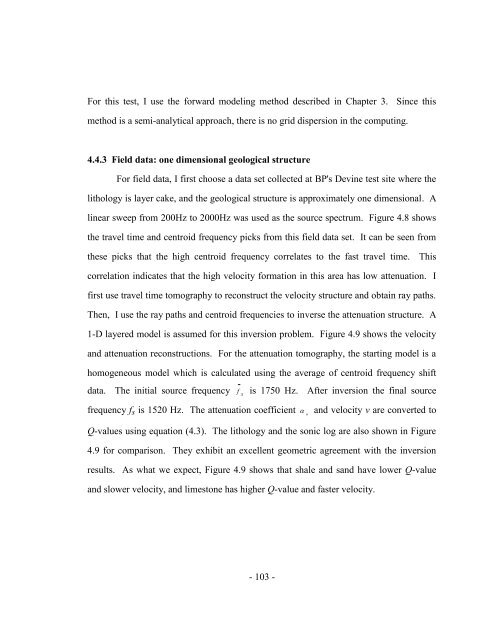My PhD Thesis, PDF 3MB - Stanford University
My PhD Thesis, PDF 3MB - Stanford University
My PhD Thesis, PDF 3MB - Stanford University
Create successful ePaper yourself
Turn your PDF publications into a flip-book with our unique Google optimized e-Paper software.
For this test, I use the forward modeling method described in Chapter 3. Since this<br />
method is a semi-analytical approach, there is no grid dispersion in the computing.<br />
4.4.3 Field data: one dimensional geological structure<br />
For field data, I first choose a data set collected at BP's Devine test site where the<br />
lithology is layer cake, and the geological structure is approximately one dimensional. A<br />
linear sweep from 200Hz to 2000Hz was used as the source spectrum. Figure 4.8 shows<br />
the travel time and centroid frequency picks from this field data set. It can be seen from<br />
these picks that the high centroid frequency correlates to the fast travel time. This<br />
correlation indicates that the high velocity formation in this area has low attenuation. I<br />
first use travel time tomography to reconstruct the velocity structure and obtain ray paths.<br />
Then, I use the ray paths and centroid frequencies to inverse the attenuation structure. A<br />
1-D layered model is assumed for this inversion problem. Figure 4.9 shows the velocity<br />
and attenuation reconstructions. For the attenuation tomography, the starting model is a<br />
homogeneous model which is calculated using the average of centroid frequency shift<br />
data. The initial source frequency f S is 1750 Hz. After inversion the final source<br />
frequency fs is 1520 Hz. The attenuation coefficient o and velocity v are converted to<br />
Q-values using equation (4.3). The lithology and the sonic log are also shown in Figure<br />
4.9 for comparison. They exhibit an excellent geometric agreement with the inversion<br />
results. As what we expect, Figure 4.9 shows that shale and sand have lower Q-value<br />
and slower velocity, and limestone has higher Q-value and faster velocity.<br />
- 103 -
















